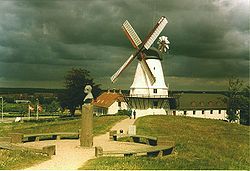
Dybbøl
Encyclopedia

South Jutland County
South Jutland County is a former county on the south-central portion of the Jutland Peninsula in southern Denmark....
, Denmark
Denmark
Denmark is a Scandinavian country in Northern Europe. The countries of Denmark and Greenland, as well as the Faroe Islands, constitute the Kingdom of Denmark . It is the southernmost of the Nordic countries, southwest of Sweden and south of Norway, and bordered to the south by Germany. Denmark...
. It is located around 6 km (3.7 mi) west of Sønderborg
Sønderborg
Sønderborg Municipality , is a municipality in Region of Southern Denmark partially on the Jutland peninsula and partially on the island of Als in south Denmark, at the border with Germany. The municipality covers an area of , and has a total population of 76,236...
.
During the 1864 Second War of Schleswig
Second War of Schleswig
The Second Schleswig War was the second military conflict as a result of the Schleswig-Holstein Question. It began on 1 February 1864, when Prussian forces crossed the border into Schleswig.Denmark fought Prussia and Austria...
, the Danish Army withdrew from the traditional fortified defence line of Dannevirke
Danevirke
The Danevirke The Danevirke The Danevirke (modern Danish spelling: Dannevirke; in Old Norse Danavirki ; in German Danewerk ; is a system of Danish fortifications in Schleswig-Holstein (Northern Germany). This important linear defensive earthwork was constructed across the neck of the Cimbrian...
(after waters and marshes which supported its flanks froze hard in a hard winter) and marched for Dybbøl to find a better defendable position. Although much artillery
Artillery
Originally applied to any group of infantry primarily armed with projectile weapons, artillery has over time become limited in meaning to refer only to those engines of war that operate by projection of munitions far beyond the range of effect of personal weapons...
was abandoned, and the evacuation was executed in a snow-laden north gale in winter, the army arrived almost intact. The army entrenched itself at the Dybbøl Trenches, which became the scene of the siege and subsequent Battle of Dybbøl
Battle of Dybbøl
The Battle of Dybbøl was the key battle of the Second War of Schleswig and occurred on the morning of 18 April 1864 following a siege lasting from 7 April. Denmark suffered a severe defeat against the German Confederation which decided the war...
(April 7 – April 18, 1864). This battle resulted in a Prussia
Prussia
Prussia was a German kingdom and historic state originating out of the Duchy of Prussia and the Margraviate of Brandenburg. For centuries, the House of Hohenzollern ruled Prussia, successfully expanding its size by way of an unusually well-organized and effective army. Prussia shaped the history...
n-Austria
Austria
Austria , officially the Republic of Austria , is a landlocked country of roughly 8.4 million people in Central Europe. It is bordered by the Czech Republic and Germany to the north, Slovakia and Hungary to the east, Slovenia and Italy to the south, and Switzerland and Liechtenstein to the...
n victory over Denmark.
In the following peace settlement, Denmark surrendered both Schleswig
Schleswig
Schleswig or South Jutland is a region covering the area about 60 km north and 70 km south of the border between Germany and Denmark; the territory has been divided between the two countries since 1920, with Northern Schleswig in Denmark and Southern Schleswig in Germany...
and Holstein
Holstein
Holstein is the region between the rivers Elbe and Eider. It is part of Schleswig-Holstein, the northernmost state of Germany....
. Following World War I
World War I
World War I , which was predominantly called the World War or the Great War from its occurrence until 1939, and the First World War or World War I thereafter, was a major war centred in Europe that began on 28 July 1914 and lasted until 11 November 1918...
, Denmark recovered the northern part of Schleswig as a result of the Schleswig Plebiscites
Schleswig Plebiscites
The Schleswig Plebiscites were two plebiscites, organized according to section XII, articles 109 to 114 of the Treaty of Versailles of June 28, 1919, in order to determine the future border between Denmark and Germany through the former duchy of Schleswig...
as described in the Treaty of Versailles
Treaty of Versailles
The Treaty of Versailles was one of the peace treaties at the end of World War I. It ended the state of war between Germany and the Allied Powers. It was signed on 28 June 1919, exactly five years after the assassination of Archduke Franz Ferdinand. The other Central Powers on the German side of...
.
The site is today a national memorial and museum about the Battle of Dybbøl. The Dybbøl Mill is considered a Danish national symbol.
Dybbøl is also the birthplace of American landscape architect Jens Jensen
Jens Jensen (landscape architect)
Jens Jensen was a Danish-American landscape architect.-Early life:Jens Jensen was born near Dybbøl in Slesvig, Denmark, in 1860, to a wealthy farming family. For the first nineteen years of his life he lived on his family's farm, which cultivated his love for the natural environment...
.

